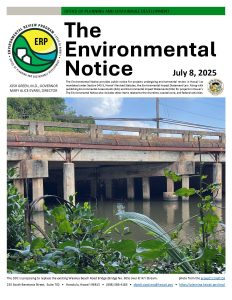Home
Please contact us for any questions or inquiries for the Environmental Review Program or the Environmental Advisory Council. Please allow 1 or 2 business days to respond. All office visits are by appointment only.
The Environmental Review Program (ERP) facilitates Hawaiʻi’s environmental review process (commonly known as HEPA), pursuant to Chapter 34 3, Hawaiʻi Revised Statutes.
3, Hawaiʻi Revised Statutes.
The office announces the availability of environmental assessments (EAs) and environmental impact statements (EISs) for public review and comment in its semi-monthly publication, The Environmental Notice. Please access the most recent issue to find notifications of open public comment periods for draft EAs and EISs, as well as summaries of proposed actions, details of upcoming EIS public scoping meetings, and other relevant notices. ERP staff may also review and comment on these documents and provide assistance throughout the environmental review process. To subscribe, please enter your email address on the right.
The current rules for the HEPA process, HAR Chapter 11-200.1, have been in effect since Aug. 9, 2019, after Governor Ige signed them on July 30, 2019. If interested in a discussion of the ideas and concepts behind the changes from the repealed HAR Chapter 11-200 to the recently adopted HAR Chapter 11-200.1, please review the Version 2.0 Rationale document. For details on the actual changes, please review the unofficial Ramseyer version in Appendix 2 of the Rationale document.
Documents submitted to ERP must adhere to the following criteria:
1. Ensure that files (ie. word, excel, pdf) are unlocked, searchable, and Americans with Disabilities Act (ADA) Compliant.
2. By April 2026, all files submitted must be 100% ADA compliant (Title II of the ADA).
3. For purposes of the submission deadline in HAR Section 11-200.1-5(a), the term “close of business” means 11:59 P.M.
 |
The Environmental NoticeThe Environmental Notice is published on the 8th and 23rd of each month and includes actions undergoing environmental review in Hawaiʻi, along with habitat conservation plans, safe harbor agreements, coastal zone and shoreline notices, some federal EAs and EISs under the National Environmental Policy Act (NEPA), and more. Current and previous issues are online. |
|
|
Online Library of EAs and EISsBrowse the office’s online library of draft and final environmental assessments and environmental impact statements, as well as withdrawals, acceptances, and supplemental determinations. Please be aware that the library is composed of 3 sections, that relate to 3 different rules that governed the process over time (pre-1996, 1996-2019, 2019-present). Some published EAs and EISs were processed pursuant to NEPA or ROH Chapter 25 (for the SMA on Oahu) and can be found in the Other TEN Publications webpage. |
 |
ExemptionsAgencies may declare minor or routine actions that trigger Hawaiʻi environmental review, whether proposed by themselves or by applicants, exempt from the requirement to prepare an environmental assessment. To exempt an action, the agency may either: (1) assert that the specific activity does not have the potential to adversely affect the environment [i.e., be considered “de minimis“], or (2) show that it falls within one of the 10 General types of action established in HAR § 11-200.1-15(c) and then obtain the advice of other agencies or individuals with jurisdiction or expertise on the exemption. However, agencies always have the discretion to choose not to exempt a particular action. When agencies make such a type (2) exemption, they are required to A) submit a monthly list of such determinations for inclusion in the issue of The Environmental Notice that is published on the 8th of the following month (look to the Publication Calendar for submittal deadlines), and B) maintain their exemption notice in their files and provide it for review upon request by the public. Agencies can guide their exemption determinations by identifying the activity on their Environmental Advisory Council-concurred exemption list. |
|
|
Guidance & Forms (ADA compliant)Find the ERP’s citizen’s guide to Hawaiʻi’s environmental policy act (HEPA), the more detailed guidebook, the 2025 publication calendar for The Environmental Notice, guidance for preparing documents under HEPA, and more. If you are prompted to log in, click CANCEL or try clearing your internet browser’s cookies. |
|
|
LawsClick here for ERP’s unofficial compilation of Hawaiʻi’s environmental review laws. Relevant statutes include: Chapter 343, HRS, on environmental impact statements and Chapter 344, HRS, on the state environmental policy. Processes to implement these statutes are established in Chapter 11-200.1, Hawaiʻi Administrative Rules (HAR), on environmental impact statements. |
 |
Environmental Impact Statement Rules UpdateIn 2019, the Environmental Advisory Council repealed HAR Chapter 11-200 and adopted HAR Chapter 11-200.1. This chapter establishes the procedures, content requirements, criteria, and definitions for applying Hawaiʻi Revised Statutes (HRS) Chapter 343, the environmental impact statement law. The rules update page includes links to Council meeting agendas and minutes, draft rules documents, and a timeline of events. |
 |
Environmental Advisory CouncilThe Council serves as a liaison between the OPSD and the public on matters concerning ecology and environmental quality. The Council also monitors the progress of state, county, and federal agencies in achieving the State’s environmental goals and policies. Importantly, the Council, after seeking public input, will advise OPSD on recommended HEPA rule changes. Its 15 members are appointed by the governor. Agendas and minutes for their monthly meetings are open to the public. Monthly meetings and outreach activities and other videos are on the Recordings page. An archive of annual reports is also online. |


